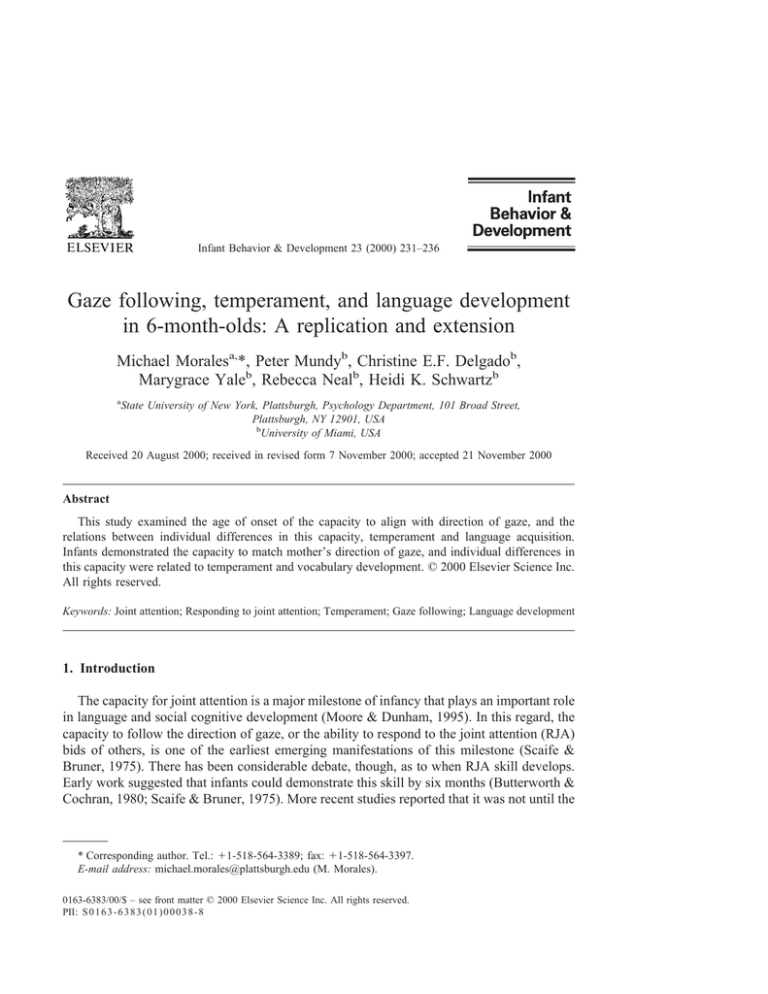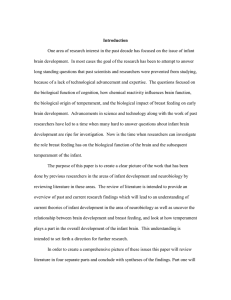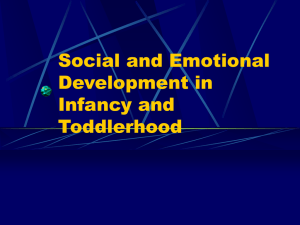
Infant Behavior & Development 23 (2000) 231–236
Gaze following, temperament, and language development
in 6-month-olds: A replication and extension
Michael Moralesa,*, Peter Mundyb, Christine E.F. Delgadob,
Marygrace Yaleb, Rebecca Nealb, Heidi K. Schwartzb
a
State University of New York, Plattsburgh, Psychology Department, 101 Broad Street,
Plattsburgh, NY 12901, USA
b
University of Miami, USA
Received 20 August 2000; received in revised form 7 November 2000; accepted 21 November 2000
Abstract
This study examined the age of onset of the capacity to align with direction of gaze, and the
relations between individual differences in this capacity, temperament and language acquisition.
Infants demonstrated the capacity to match mother’s direction of gaze, and individual differences in
this capacity were related to temperament and vocabulary development. © 2000 Elsevier Science Inc.
All rights reserved.
Keywords: Joint attention; Responding to joint attention; Temperament; Gaze following; Language development
1. Introduction
The capacity for joint attention is a major milestone of infancy that plays an important role
in language and social cognitive development (Moore & Dunham, 1995). In this regard, the
capacity to follow the direction of gaze, or the ability to respond to the joint attention (RJA)
bids of others, is one of the earliest emerging manifestations of this milestone (Scaife &
Bruner, 1975). There has been considerable debate, though, as to when RJA skill develops.
Early work suggested that infants could demonstrate this skill by six months (Butterworth &
Cochran, 1980; Scaife & Bruner, 1975). More recent studies reported that it was not until the
* Corresponding author. Tel.: ⫹1-518-564-3389; fax: ⫹1-518-564-3397.
E-mail address: michael.morales@plattsburgh.edu (M. Morales).
0163-6383/00/$ – see front matter © 2000 Elsevier Science Inc. All rights reserved.
PII: S 0 1 6 3 - 6 3 8 3 ( 0 1 ) 0 0 0 3 8 - 8
232
M. Morales et al. / Infant Behavior & Development 23 (2000) 231–236
10- to 12-month age period that infants reliably demonstrated the ability to RJA (e.g.,
Corkum & Moore, 1998). The discrepancy in findings has been attributed to differences in
whether researchers considered errors, or the tendency of infants to turn their heads away
from the direction of gaze of a social partner, as well as correctly turning in the direction of
a gaze shift and head turn of a social partner in determining whether this skill is consistently
manifest at a specific age in infancy (Corkum & Moore, 1998).
A recent study, though, has employed the rigorous methods of Corkum and Moore (1998),
as well as an ecologically based paradigm involving parents, and again observed that infants
as young as six months demonstrate the capacity to respond to joint attention bids (Morales,
Mundy, & Rojas, 1998). Moreover, further support for the notion that infants were actually
demonstrating joint attention skill was provided by the observation that six-month-old gaze
following was related in a theoretically meaningful way to later language development.
These observations were very important, but they were based on a single study of a small
sample of infants. Hence, the need to replicate these observations has been emphasized in
several reports (Morales et al., 1998; Morales et al., 2000). Thus, the primary goal of this
study was to examine two hypotheses in a second longitudinal study of an independent
sample. First, six-month-old infants were expected to demonstrate the capacity for RJA, and
second, that six-month RJA skill was expected to relate to early vocabulary acquisition.
To extend knowledge in this area, this study was also designed to examine hypotheses
about associations between temperament, RJA ability, and language. Research suggests that
temperament may be related to early language development (Dixon & Shore, 1997; Matheny,
1989; Slomkowski et al., 1992). In addition, temperament may be one factor that plays a role
in joint attention development (Mundy, 1995; Mundy & Willoughby, 1996) and its connections to language (Mundy & Gomes, 1998). Indeed, a potential corollary of theory suggesting
that attention-related constructs such as duration of orienting, inhibition, and distractibility
are prominent aspects of individual differences in infant temperament (Derryberry & Rothbart, 1984; Ruff & Rothbart, 1996), is that these dimensions of temperament may be integral
to individual differences in the development of joint attention skills in infants. In this regard,
it is interesting to note that the brain systems that may be involved in these dimensions of
temperament, such as parietal functions (Rothbart, Posner, & Rosicky, 1994), have also
recently been linked to RJA skill development in an EEG study of infant development
(Mundy, Card & Fox, 2000). Thus, a third hypothesis examined in this study was that
temperament may be related to individual differences in RJA development in infants.
These hypotheses were examined in a longitudinal study of 6- and 12-month-old infants.
Participants were 52 infants (26 boys, 26 girls) and their mothers from two-parent middle to
upper middle SES families (Hollingshead, 1978). Maternal education ranged from high
school to postgraduate level, with the median education level being four years of college.
Fourteen children were Caucasian (non Hispanic), sixteen were Hispanic, five were African
American, and 17 were of multiethnic background.
In the assessment of RJA the infant was seated in a high chair, and the parent was seated
facing her infant. Each session began with a 7-min face-to-face interaction. Immediately
following this interaction, mothers were instructed to present three consecutive trials to their
infant in which they turned and fixated a target that was 90 degrees to the right or left of the
infant, or 180 degrees behind the infant. During each head turn trial, parents said their child’s
M. Morales et al. / Infant Behavior & Development 23 (2000) 231–236
233
Table 1
Descriptive statistics for RJA, language, and temperament measures
RJA measure
Correct trials:
Left/right trials
Behind trials
Combined trials
Incorrect trials:
Left/right trials
Behind trials
Combined trials
Language measure
Receptive percentile score
Expressive percentile score
Temperament measure
Activity level
Distress to limitations
Distress to novelty
Duration of orienting
Smiling and laughter
Soothability
M
SD
1.62
0.03
1.65
1.22
0.19
1.23
0.90
0.77
1.67
0.82
0.83
1.42
64.33
47.62
23.09
31.56
4.47
3.50
2.67
4.05
5.22
5.33
0.76
0.69
0.82
0.98
0.75
0.93
name emphatically three times, but they maintained their gaze on the referent target throughout the trial. After each trial, mothers returned their gaze to midline before executing the next
trial.
Two independent coders rated videotapes for direction of the first infant gaze or head turn
in the horizontal plane to occur during each trial. As in our prior study, a gaze or head turn
was scored as a correct response if it was in the same direction of the adult’s head turn. A
gaze or head turn was scored as an incorrect response if it was in the opposite direction of
the adult’s head turn (see Morales et al., 1998 for scoring details). Infant response scores
were used to compute a difference score for each infant to test whether or not infants reliably
demonstrated the ability to follow gaze. The difference score was calculated by subtracting
the number of incorrect responses from the number of correct responses. Interrater reliability
for infant RJA responses was assessed using 10 randomly selected videotapes. Paired sample
correlations calculated for first correct and first incorrect infant response were r(10) ⫽ 0.99,
p ⬍ .0001, and r(10) ⫽ 0.94, p ⬍ .0001, respectively.
The Infant Behavior Questionnaire (IBQ) was used to assess infant temperament at 6
months of age. The IBQ is a 94-item parent-report instrument designed to assess six
temperamental dimensions including activity level, distress to limitations, distress to novel
situations, duration of orienting, smiling and laughing, and soothability (Rothbart, 1981).
The items that comprise the IBQ were designed to reflect common situations that elicit
behaviors related to the aforementioned dimensions of temperament. Parents are asked to
rate their agreement with each item on a Likert-type scale ranging from “Never does this” (1)
to “Always does this” (7). The MacArthur Short Form Vocabulary Checklist: Level I
(MCDI), a parent-report vocabulary measure, was used to assess infant’s basic expressive
and receptive vocabulary at 12 months. Descriptive statistics for RJA, language, and
temperament measures are presented in Table 1.
234
M. Morales et al. / Infant Behavior & Development 23 (2000) 231–236
Table 2
Correlations among responding to joint attention, temperament, and language
Language measure
Receptive
Responding to joint attention measures
Difference score all trials
ifference score left/right trials
Temperament measures
Activity level
Distress to limitations
Distress to novelty
Duration of orienting
Smiling and laughter
Soothability
†
.24†
.28*
.40**
⫺.09
⫺.01
.31*
.40**
.25†
Expressive
.06
.08
.05
⫺.05
.18
.14
.16
⫺.06
p ⬍ .10; * p ⬍ .05; ** p ⬍ .01.
To test if infants were reliably demonstrating the capacity for RJA, mean difference scores
were calculated for left and right trials combined (M ⫽ 0.73, SD ⫽ 1.52), behind trials (M ⫽
⫺0.73, SD ⫽ 0.87), and total trials combined (M ⫽ ⫺0.06, SD ⫽ 1.72). One-Sample t tests
(two-tailed) were conducted using mean difference scores. Results indicated that the mean
difference score for left and right trials combined was significantly greater than 0 (t(51) ⫽
3.46, p ⬍ .001), while the mean difference score for behind trials was significantly less than
0 (t(51) ⫽ ⫺6.07, p ⬍ .0001). Consequently, the mean difference score for all trials
combined failed to reach significance (t(51) ⫽ ⫺0.24, ns.). These findings replicated Morales
et al. (1998) and suggest that a substantial number of six-month-old infants reliably demonstrated the capacity to RJA on left and right trials where parents fixated targets within the
infant’s visual field. However, as in Morales et al. (1998), six-month-old infants were unable
to RJA when adults fixated targets outside (behind) the infant’s visual field.
Pearson-Product Moment correlation data on the relations between RJA difference scores,
IBQ dimensions scores and MCDI percentile scores for receptive and expressive language
are presented in Table 2. As in our prior study, individual differences in infant’s RJA ability,
as indexed by difference scores for left and right trials, were significantly related to infant’s
receptive vocabulary. With respect to temperament and language, activity level, duration of
orienting, and smiling and laughter were positively related to receptive vocabulary. No
relations were found between RJA and expressive vocabulary, or temperament and expressive vocabulary. The latter findings are not surprising given the low likelihood that any
meaningful individual differences in expressive language would be found using any kind of
language measure at 12 months.
Examination of relations between temperament and RJA revealed a significant association
between the RJA difference scores on all trials and duration of orienting, r(52) ⫽ 0.28, p ⬍ .05.
Marginal associations were found between RJA difference scores for all trials and soothability (r(52) ⫽ 0.23, p ⬍ .10) and RJA difference scores for left/right trials and duration of
orienting (r(52) ⫽ 0.26, p ⬍ .06). Hierarchical linear regression analyses indicated that
duration of orienting and RJA score for left/right trials combined to predict receptive
vocabulary R ⫽ 0.37, R2 ⫽ 0.14, F(2, 49) ⫽ 3.98, p ⬍ .05. There was virtually no difference
M. Morales et al. / Infant Behavior & Development 23 (2000) 231–236
235
between the regression coefficients for these two variables (orienting,  ⫽ 0.25, p ⬍ .07;
RJA,  ⫽ 0.22, p ⬍ .12) suggesting that both parent report of attention regulation and direct
observation of RJA contributed equally to the prediction of parent report of language in this
study.
The current findings, together with our prior research, suggest that meaningful individual
differences in joint attentional skills may exist as early as 6 months of age. Moreover, our
research suggests that individual differences in the ability to match direction of gaze may be
related to early language development, either measured by parent report as in this study, or
by standardized assessment, as in Morales et al. (2000).
Our observation that duration of orienting, smiling and laughter, and soothability were
correlated with receptive vocabulary was consistent with prior research investigating linkages between temperament and language. For example, Dixon and Shore (1997) found that
duration of orienting and soothability at 13 months were significantly correlated with an
analytic/holistic language style at 20 months (i.e. a language style that has a large proportion
of nouns in early vocabulary, and a high proportion of noun-noun constructions in early
grammar), and that all three of the aforementioned dimensions of temperament were
significantly correlated with this language style at 21 months.
A unique aspect of our study was the observed relations between RJA and aspects of
temperament. Responding to joint attention was correlated with mother-reported duration of
orienting suggesting that RJA may be linked with more general aspects of individual
variation in the development of attention regulation skill in infancy. Moreover, it was not
clear from this study, though, whether RJA has a more specific link to language development
than other more general aspects of attention regulation, even though theory would suggest
this is the case (Baldwin, 1995; Tomasello, 1995). Further research using more precise
measures of attention regulation, as well parent report of temperament, will be needed to
examine this important issue more thoroughly.
Ackowledgments
This study was conducted with the support of NIDCD grant #00484 and NICHD grant
#38052, and could not have been completed without the assistance of Rebecca Eilers and
Kim Oller.
References
Baldwin, D. A. (1995). Understanding the link between joint attention and language. In C. Moore & P. J. Dunham
(Eds.), Joint attention: its origins and role in development (pp. 131–158). Hillsdale, NJ: Erlbaum.
Butterworth, G., & Cochran, E. (1980). Towards a mechanism of joint visual attention in human infancy.
International Journal of Behavioral Development, 3, 253–272.
Corkum, V. L., & Moore, C. (1998). The origins of joint attention. Developmental Psychology, 34, 28 –38.
Derryberry, D., & Rothbart, M. K. (1984). Arousal, affect, and attention as components of temperament. Journal
of Personality and Social Psychology, 55, 958 –966.
Dixon, W., & Shore, C. (1997). Temperamental predictors of linguistic style during multiword acquisition. Infant
Behavior and Development, 20, 99 –103.
236
M. Morales et al. / Infant Behavior & Development 23 (2000) 231–236
Hollingshead, A. B. (1978). Two-factor index of social status. New Haven, CT: Yale University Press.
Matheny Jr., A. P. (1989). Temperament and cognition: relations between temperament and mental test scores.
In G. A. Kohnstamm, J. E. Bates & M. K. Rothbart (Eds.), Temperament in childhood. New York: Wiley.
Moore, C., & Dunham, P. J. (1995). Joint attention: its origins and role in development. Hillsdale, NJ: Lawrence
Erlbaum Associates.
Morales, M., Mundy, P., Delgado, C. E. F., Yale, M., Messinger, D., Neal, R., & Schwartz, H. K. (2000).
Responding to joint attention across the 6- to 24-month age period and early language acquisition. Journal of
Applied Developmental Psychology, 21, 283–298.
Morales, M., Mundy, P., & Rojas, J. (1998). Following the direction of gaze and language development in
6-month-olds. Infant Behavior and Development, 21, 373–377.
Mundy, P. (1995). Joint attention, social-emotional approach in children with autism. Development and Psychopathology, 7, 63– 82.
Mundy, P., Card, J., & Fox, N. (2000). EEG correlates of the development of infant joint attention skills.
Developmental Psychobiology, 36, 325–338.
Mundy, P., & Gomes, A. (1998). Individual differences in joint attention skill development in the second year.
Infant Behavior and Development, 21, 469 – 482.
Mundy, P., & Willoughby, J. (1996). Nonverbal communication, joint attention, and social-emotional development. In M. Lewis & M. Sullivan (Eds.), Emotional development in atypical children (pp. 65– 87). New York:
Wiley.
Rothbart, M. K. (1981). Measurement of temperament in infancy. Child Development, 52, 569 –578.
Rothbart, M. K., Posner, M. I., & Rosicky, J. (1994). Orienting in normal and pathological development.
Development & Psychopathology, 6, 635– 652.
Ruff, H. A., & Rothbart, M. K. (1996). Attention in early development: themes and variation. New York: Oxford
University Press.
Scaife, M., & Bruner, J. S. (1975). The capacity for joint visual attention in the infant. Nature, 253, 265–266.
Slomkowski, C. L., Nelson, K., Dunn, J., & Plomin, R. (1992). Temperament and language: relations from
toddlerhood to middle childhood. Developmental Psychology, 28, 1090 –1095.
Tomasello, M. (1995). Joint attention as social cognition. In C. Moore & P. J. Dunham (Eds.), Joint attention:
its origins and role in development (pp. 103–130). Hillsdale, NJ: Erlbaum.



